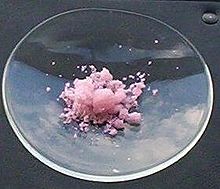
| |
| Names | |
|---|---|
| IUPAC name
Erbium(III) chloride
| |
| Other names
Erbium trichloride
| |
| Identifiers | |
| |
3D model (JSmol)
|
|
| ChemSpider | |
| ECHA InfoCard | 100.030.337 |
| EC Number |
|
PubChem CID
|
|
| UNII | |
CompTox Dashboard (EPA)
|
|
| |
| |
| Properties | |
| ErCl3 (anhydrous) ErCl3·6H2O (hexahydrate) | |
| Molar mass | 273.62 g/mol (anhydrous) 381.71 g/mol (hexahydrate) |
| Appearance | violet hygroscopic monoclinic crystals (anhydrous) pink hygroscopic crystals (hexahydrate) |
| Density | 4.1 g/cm3 (anhydrous) |
| Melting point | 776 °C (1,429 °F; 1,049 K) (anhydrous) decomposes (hexahydrate) |
| Boiling point | 1,500 °C (2,730 °F; 1,770 K) |
| soluble in water (anhydrous) slightly soluble in ethanol (hexahydrate)[1] | |
| Structure[2] | |
| monoclinic | |
| C2/m, No. 12 | |
a = 6.80 Å, b = 11.79 Å, c = 6.39 Å α = 90°, β = 110.7°, γ = 90°
| |
Lattice volume (V)
|
479 Å3 |
Formula units (Z)
|
4 |
| Related compounds | |
Other anions
|
Erbium(III) oxide |
Other cations
|
Holmium(III) chloride, Thulium(III) chloride |
Except where otherwise noted, data are given for materials in their standard state (at 25 °C [77 °F], 100 kPa).
| |
Erbium(III) chloride is a violet solid with the formula ErCl3. It is used in the preparation of erbium metal.
- ^ Lide, David R. (1998). Handbook of Chemistry and Physics (87 ed.). Boca Raton, Florida: CRC Press. pp. 4–57. ISBN 0-8493-0594-2.
- ^ Cite error: The named reference
Tempeltonwas invoked but never defined (see the help page).